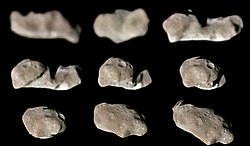243 Ida
 Galileo image of 243 Ida. The tiny dot to the right is its moon, Dactyl. | |||||||||||||
| Discovery[1] | |||||||||||||
|---|---|---|---|---|---|---|---|---|---|---|---|---|---|
| Discovered by | Johann Palisa | ||||||||||||
| Discovery date | September 29, 1884 | ||||||||||||
| Designations | |||||||||||||
| A910 CD; 1988 DB1 | |||||||||||||
| Main belt (Koronis) | |||||||||||||
| Orbital characteristics[2] | |||||||||||||
| Epoch October 22, 2004 (JD 2453300.5) | |||||||||||||
| Aphelion | 447.843 Gm (2.994 AU) | ||||||||||||
| Perihelion | 408.207 Gm (2.729 AU) | ||||||||||||
| 428.025 Gm (2.861 AU) | |||||||||||||
| Eccentricity | 0.046 | ||||||||||||
| 1767.724 d (4.84 a) | |||||||||||||
Average orbital speed | 17.60 km/s | ||||||||||||
| 245.469° | |||||||||||||
| Inclination | 1.138° | ||||||||||||
| 324.218° | |||||||||||||
| 108.754° | |||||||||||||
| Known satellites | Dactyl | ||||||||||||
| Physical characteristics | |||||||||||||
| Dimensions | 53.6×24.0×15.2 km | ||||||||||||
| 15.7 km | |||||||||||||
| Mass | 4.2×1016 kg 1 | ||||||||||||
Mean density | 2.6 g/cm³[2] | ||||||||||||
Equatorial surface gravity | 0.0109 m/s² | ||||||||||||
Equatorial escape velocity | 0.0185 km/s | ||||||||||||
| 0.1931 d (4 h 37 min)[2] | |||||||||||||
| 0.2383[2] | |||||||||||||
| |||||||||||||
| S[2] | |||||||||||||
| 9.94[2] | |||||||||||||
243 Ida (Template:PronEng eye'-də) is a Main belt asteroid that was imaged by the Galileo spacecraft on August 28, 1993. It was the first binary asteroid to be discovered and is a member of the Koronis family of asteroids.
Discovery and name
Ida was discovered by Johann Palisa on September 29, 1884 in Vienna. It is named after Ida, a Cretan nymph in Greek mythology who lived on a mountain that bore her name (see Mount Ida, Crete).
Moon
Ida has a small moon, Dactyl, which was discovered on February 17, 1994 by Galileo mission member Ann Harch, while examining the delayed image downloads. The moon was given the provisory designation S/1993 (243) 1 and later named (243) Ida I Dactyl. The discovery images were taken on 28 August 1993, hence the provisory designation. The satellite was reported on 12 March 1994.
Dactyl is only 1.4 km in diameter. Some researchers believe that Dactyl formed from debris ejected from Ida by cratering, while others suggest that Ida and Dactyl formed as a pair a billion or more years ago when Ida's parent body was disrupted. Both of these hypotheses present difficulties that remain unresolved at this time. Since the discovery of Dactyl, other observations have suggested that asteroid moons are common.
Although Ida's dimensions, measured along the principal axes (based on its rotation) are 53.6×24.0×15.2 km, the best-fit ellipsoid measures 60.0×25.2×18.6 km. The maximum deviation from this ellipsoid remains quite large, at 8.4 km. Since its mass is accurately known thanks to its little moon, one can calculate that its surface gravity varies between 0.0031 and 0.0324 m/s² depending on one's position on its surface. The rotation axis is within one degree of the shorter dimension axis, which means the centrifugal effect can reach a value as large as 0.0042 m/s² —at the tips of its longest axes, Ida is actually under tension.
Physical characteristics


Ida
The image accompanying this article was made from images taken by the Galileo spacecraft about 14 minutes before its closest approach to 243 Ida on August 28, 1993. The range from the spacecraft was approximately 10,500 kilometers (6,500 miles). The images used are from the sequence in which Ida's moon was originally discovered; the moon is visible to the right of the asteroid. This picture is made from images through the 410 nanometres (violet), 756 nm (infrared) and 968 nm (infrared) filters. The color is 'enhanced' in the sense that the CCD camera is sensitive to near infrared wavelengths of light beyond human vision; a 'natural' color picture of this asteroid would appear mostly gray.
Shadings in the image indicate changes in illumination angle on the many steep slopes of this irregular body as well as subtle color variations due to differences in the physical state and composition of the soil (regolith). There are brighter areas, appearing bluish in the picture, around craters on the upper left end of Ida, around the small bright crater near the center of the asteroid, and near the upper right- hand edge (the limb). This is a combination of more reflected blue light and greater absorption of near infrared light, suggesting a difference in the abundance or composition of iron-bearing minerals in these areas.
Dactyl
Ida's moon also has a deeper near-infrared absorption and a different color in the violet than any area on this side of Ida. The moon is not identical in spectral properties to any area of Ida in view here, though its overall similarity in reflectance and general spectral type suggests that it is made of the same rock types basically. These data, combined with study of further imaging data and more detailed spectra from the Near Infrared Mapping Spectrometer, may allow scientists to determine whether the larger parent body of which Ida, its moon, and some other asteroids are fragments was a heated, differentiated object or made of relatively unaltered primitive chondritic material.
See also
References
- P. C. Thomas, M. J. S. Belton, B. Carcich, C. R. Chapman, M. E. Davies, R. Sullivan, and J. Veverka; The shape of Ida, Icarus, Issue 1, No. 120, pp. 20-32, 1996.
- M. E. Davies, T. R. Colvin, M. J. S. Belton, P. C. Thomas, J. Veverka, The Galileo Imaging Science Team, The North Pole Direction and the Control Network of the Asteroid 243 Ida, Bulletin of the American Astronomical Society, Vol. 26, p. 1154, June 1994
- Report of the IAU/IAG Working Group on Cartographic Coordinates and Rotational Elements of the Planets and Satellites, 2000
- The Asteroid Orbital Elements Database
- Minor Planet Discovery Circumstances
- IAUC 6082 announcing Dactyl's naming
External links
- Orbital simulation from JPL (Java) / Ephemeris
